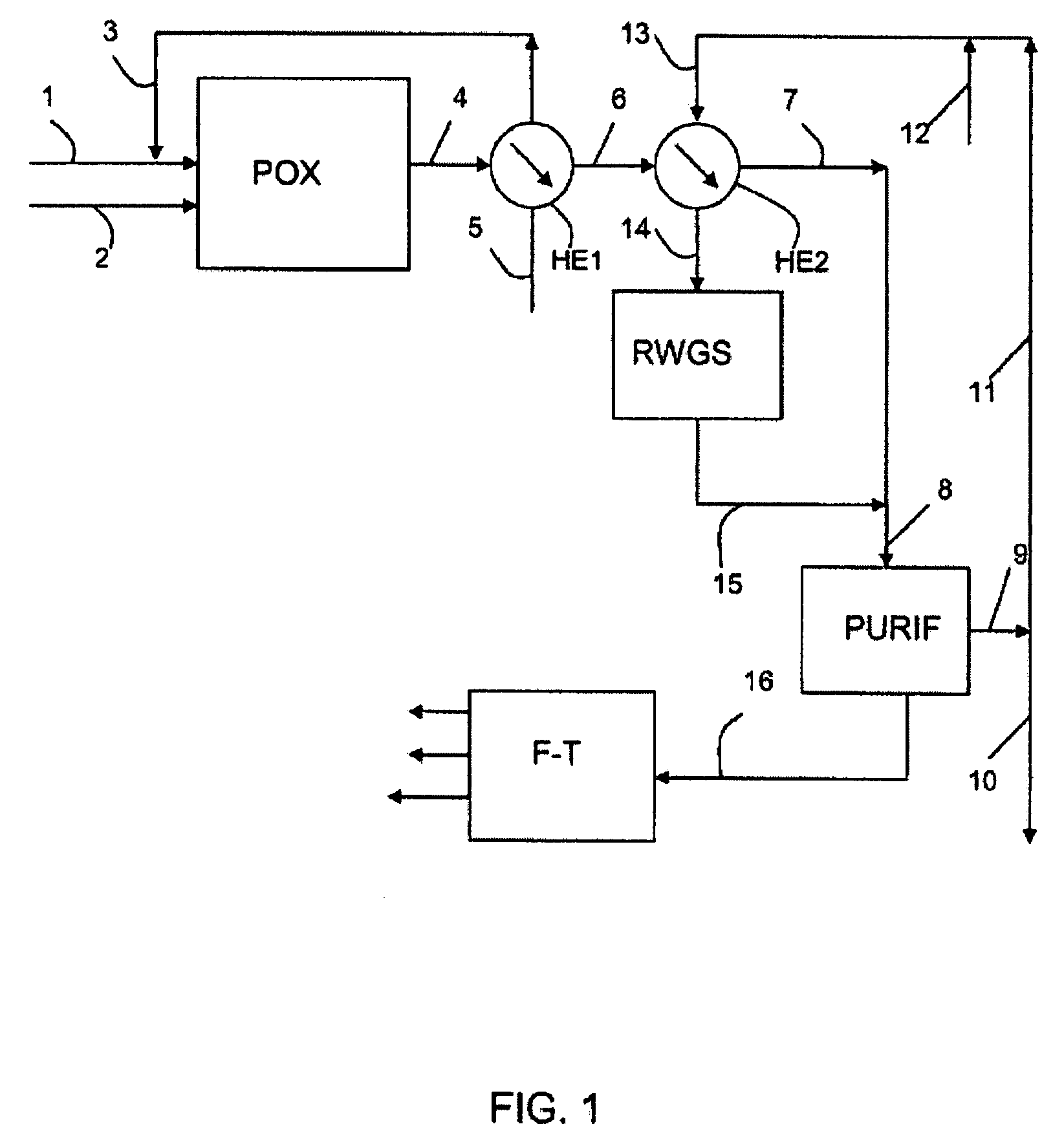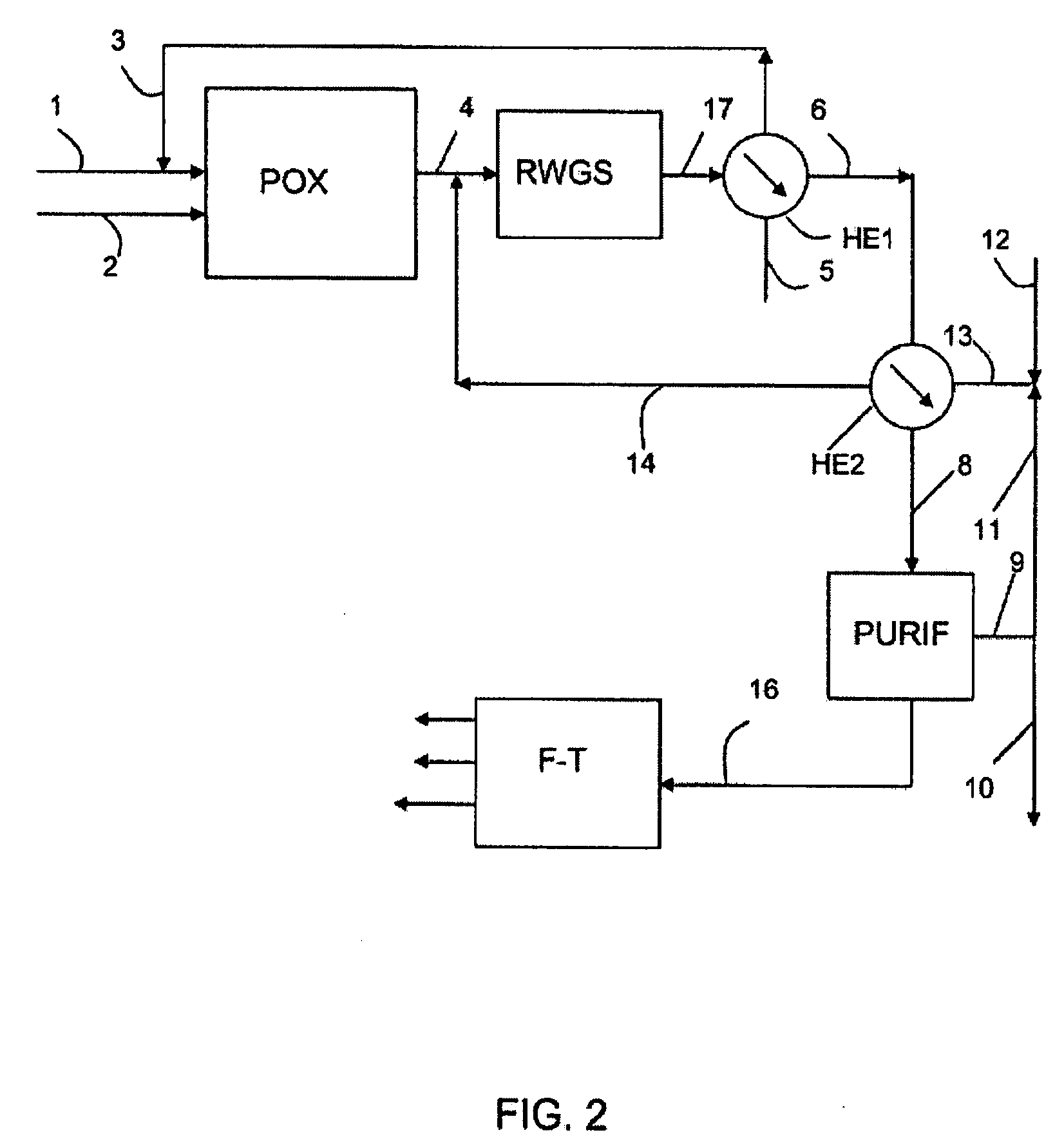Process for the production of synthesis gas with conversion of CO2 into hydrogen
a technology of synthesis gas and hydrogen, which is applied in the direction of combustible gas production, combustible gas purification/modification, sustainable manufacturing/processing, etc., can solve the problems of incompatibility with heavy carbon-containing feedstocks, impurities, and inability to use light feedstocks, and reduce the amount of co that can be converted into hydrocarbons by fischer, so as to improve energy integration and carbon yield. high
- Summary
- Abstract
- Description
- Claims
- Application Information
AI Technical Summary
Benefits of technology
Problems solved by technology
Method used
Image
Examples
example 1
According to the Prior Art
[0064]A non-dehydrated wood feedstock, with a flow rate of 30,000 kg / h including 18,000 kg / h of dry material, is used. The wood, ground in the form of fine particles of 100 micrometers or less is sent directly to the partial oxidation unit (POX), also fed by 14,603 kg / h of oxygen. The output effluent of the partial oxidation is a synthesis gas that has a molar ratio H2 / CO=0.79, with a flow rate of 44,603 kg / h, a temperature of 1,400° C., and under a pressure of 2.9 MPa. This gas is cooled, then mixed at 1,053 kg / h of external hydrogen produced by an electrolyzer, to produce 45,656 kg / h of synthesis gas including 12,435 kg / h of an H2+CO mixture with an H2 / CO molar ratio=2.15.
[0065]The electrolyzer is fed by 16,443 kg / h of water and consumes an electric power of 92 MW. It produces 14,603 kg / h of oxygen, integrally consumed by the partial oxidation unit (POX), and 1,840 kg / h of hydrogen, including 1,053 kg / h, is added to the synthesis gas, and 787 kg / h is prod...
example 2
According to the Invention
[0073]This example takes on the conditions of Example 1 by adding the following improvement thereto: the hydrogen that is produced in excess by the electrolyzer and a portion of the CO2 that is produced by the scrubbing with amines are mixed to feed a separate reactor for conversion of CO2 with hydrogen (RWGS) so as to produce a mixture of additional CO+H2, by the balanced reaction: CO2+H2 ⇄CO+H2O. The remainder of CO2 that is not recycled is purged into the atmosphere.
[0074]The conversion of CO2 with hydrogen being endothermic, it is necessary to heat the feedstock and optionally also the reactor of the unit (RWGS).
[0075]Whereby the conversion of the CO2 is promoted by a high temperature, it is possible to select the outlet temperature of the reactor so as to obtain at the outlet the desired conversion. The reactor can advantageously be a reactor-exchanger that is heated by, for example, the hot synthesis gas that is obtained from the partial oxidation (PO...
PUM
| Property | Measurement | Unit |
|---|---|---|
| temperature | aaaaa | aaaaa |
| temperature | aaaaa | aaaaa |
| temperature | aaaaa | aaaaa |
Abstract
Description
Claims
Application Information
 Login to View More
Login to View More - R&D
- Intellectual Property
- Life Sciences
- Materials
- Tech Scout
- Unparalleled Data Quality
- Higher Quality Content
- 60% Fewer Hallucinations
Browse by: Latest US Patents, China's latest patents, Technical Efficacy Thesaurus, Application Domain, Technology Topic, Popular Technical Reports.
© 2025 PatSnap. All rights reserved.Legal|Privacy policy|Modern Slavery Act Transparency Statement|Sitemap|About US| Contact US: help@patsnap.com


